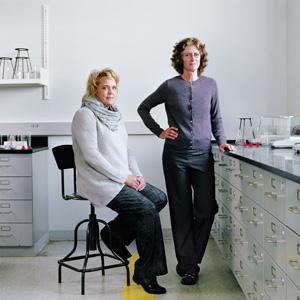Tech Team Duo Develops Innovative Cancer Treatment
 Two Virginia Tech scientists may have invented the future of cancer treatment—a way to eradicate tumors without the harmful side effects of chemotherapy, radiation or a surgeon’s scalpel.
Two Virginia Tech scientists may have invented the future of cancer treatment—a way to eradicate tumors without the harmful side effects of chemotherapy, radiation or a surgeon’s scalpel.They’ve built what chemist Karen Brewer calls a “molecular machine” that seeks out fast-replicating cancer cells and becomes lethal only when exposed to light.
Other photodynamic therapies rely on drugs that grab oxygen molecules from nearby tissue, so they are powerless against dense, fast-growing cancers—such as breast, brain, lung and prostate—with hypoxic, or oxygen-free, cores.
“I really wanted to come up with something completely different, a light-activated drug that would not require oxygen,” says Brewer, an expert at building light-triggered on/off switches for chemical compounds.
Biologist Brenda Winkel helped develop a DNA-targeting compound to
attach to the trigger. Then, Toronto-based Theralase Technologies
licensed it for use with its own deep-penetrating super-pulsed laser.
“This shows promise in terms of getting deeper-seated tissue,” says National Cancer Institute program manager Rosemary Wong. “It would allow you to address a number of different cancers.”
The new therapy has recently begun Phase II trials, part of a seven-year road map for Food and Drug Administration approval. “Cancer is really just cells that have lost the ability to die,” says Theralase president Roger Dumoulin-White.
“With the help of a compound and a light source, we’re granting that cell the ability to bow out gracefully. We’re fixing what’s really broken versus trying to cut it out.”
Click here to read the full story:
By Logan Ward
Popular Mechanics
Photo Credit:
Mark Mahaney
Related Links:
More About Cancer on AWR
“This shows promise in terms of getting deeper-seated tissue,” says National Cancer Institute program manager Rosemary Wong. “It would allow you to address a number of different cancers.”
The new therapy has recently begun Phase II trials, part of a seven-year road map for Food and Drug Administration approval. “Cancer is really just cells that have lost the ability to die,” says Theralase president Roger Dumoulin-White.
“With the help of a compound and a light source, we’re granting that cell the ability to bow out gracefully. We’re fixing what’s really broken versus trying to cut it out.”
Click here to read the full story:
By Logan Ward
Popular Mechanics
Photo Credit:
Mark Mahaney
Related Links:
More About Cancer on AWR